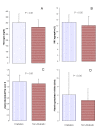Hemostatic risk factors in patients with coronary artery disease and type 2 diabetes - a two year follow-up of 243 patients
- PMID: 19735543
- PMCID: PMC2743654
- DOI: 10.1186/1475-2840-8-48
Hemostatic risk factors in patients with coronary artery disease and type 2 diabetes - a two year follow-up of 243 patients
Abstract
Background: Thrombosis is regarded to be a key factor in the development of acute coronary syndromes in patients with coronary artery disease (CAD). We hypothesize, that hemostatic and rheological risk factors may be of major relevance for the incidence and the risk stratification of these patients.
Methods: In 243 patients with coronary artery disease and stable angina pectoris parameters of metabolism, hemostasis, blood rheology and endogenous fibrinolysis were assessed. Patients were prospectively followed for 2 years in respect to elective revascularizations and acute coronary syndromes.
Results: During follow-up 88 patients presented with cardiac events, 22 of those were admitted to the hospital because of acute events, 5 Patients were excluded due to non- cardiac death. Patients with clinical events were found to be more frequently diabetic and presented with a more progressed coronary atherosclerosis. Even though patients with diabetes mellitus demonstrated a comparable level of multivessel disease (71% vs. 70%) the rate of elective revascularization was higher (41% vs. 28%, p < 0.05). The results were also unfavorable for the incidence of acute cardiovascular events (18% vs. 8%, p < 0.01). In comparison to non-diabetic patients diabetics demonstrated significantly elevated levels of fibrinogen (352 +/- 76 vs. 312 +/- 64 mg/dl, p < 0.01), plasma viscosity (1.38 +/- 0.23 vs. 1.31 +/- 0.16 mPas, p < 0.01), red blood cell aggregation (13.2 +/- 2.5 vs. 12.1 +/- 3.1 E, p < 0.05) and plasmin-activator-inhibitor (6.11 +/- 3.4 vs. 4.7 +/- 2.7 U/l, p < 0.05).
Conclusion: Pathological alterations of fibrinogen, blood rheology and plasminogen-activator-inhibitor as indicators of a procoagulant state are of major relevance for the short-term incidence of cardiac events, especially in patients with diabetes mellitus type 2, and may be used to stratify patients to specific therapies.
Figures




Similar articles
-
Hemostatic factors and the risk of myocardial infarction or sudden death in patients with angina pectoris. European Concerted Action on Thrombosis and Disabilities Angina Pectoris Study Group.N Engl J Med. 1995 Mar 9;332(10):635-41. doi: 10.1056/NEJM199503093321003. N Engl J Med. 1995. PMID: 7845427 Clinical Trial.
-
Activation of the fibrinolytic system in patients with coronary artery disease and hyperfibrinogenemia.Thromb Haemost. 1997 May;77(5):970-4. Thromb Haemost. 1997. PMID: 9184412
-
Relevance of hemostatic risk factors on coronary morphology in patients with diabetes mellitus type 2.Cardiovasc Diabetol. 2009 May 6;8:24. doi: 10.1186/1475-2840-8-24. Cardiovasc Diabetol. 2009. PMID: 19419582 Free PMC article.
-
[Blood coagulation and fibrinolysis in arteriosclerosis].Z Kardiol. 1999 May;88(5):315-23. doi: 10.1007/s003920050292. Z Kardiol. 1999. PMID: 10413853 Review. German.
-
API expert consensus document on management of ischemic heart disease.J Assoc Physicians India. 2006 Jun;54:469-80. J Assoc Physicians India. 2006. PMID: 16909697 Review.
Cited by
-
Low fasting glucose is associated with enhanced thrombin generation and unfavorable fibrin clot properties in type 2 diabetic patients with high cardiovascular risk.Cardiovasc Diabetol. 2015 May 1;14:44. doi: 10.1186/s12933-015-0207-2. Cardiovasc Diabetol. 2015. PMID: 25928628 Free PMC article.
-
Coagulatory Defects in Type-1 and Type-2 Diabetes.Int J Mol Sci. 2019 Dec 16;20(24):6345. doi: 10.3390/ijms20246345. Int J Mol Sci. 2019. PMID: 31888259 Free PMC article. Review.
-
A local-saturation-and-delay MRI method for evaluation of red blood cells aggregation in vivo for tumor-bearing or drug-used rats.Front Bioeng Biotechnol. 2023 Jan 17;11:1111840. doi: 10.3389/fbioe.2023.1111840. eCollection 2023. Front Bioeng Biotechnol. 2023. PMID: 36733963 Free PMC article.
-
Association of fibrinogen with severity of stable coronary artery disease in patients with type 2 diabetic mellitus.Dis Markers. 2014;2014:485687. doi: 10.1155/2014/485687. Epub 2014 Apr 6. Dis Markers. 2014. PMID: 24803720 Free PMC article.
-
Fibrinogen and associated risk factors in a high-risk population: urban Indigenous Australians, the DRUID Study.Cardiovasc Diabetol. 2010 Oct 29;9:69. doi: 10.1186/1475-2840-9-69. Cardiovasc Diabetol. 2010. PMID: 21029470 Free PMC article.
References
-
- Auwerx J, Bouillon R, Collen D, Geboers J. Tissue-type plasminogen activator antigen and plasminogen activator inhibitor in diabetes mellitus. Artherosclerosis. 1988;8:68–72. - PubMed
-
- Fisher BM, Quin JD, Rumley A, Lennie SE, Small M, MacCuish AC, Lowe GD. Effects of acute insulin-induced hypoglycaemia on haemostasis, fibrinolysis and haemorheology in insulin-dependent diabetic patients and control subjects. Clin Sci Colch. 1991;8:525–531. - PubMed
-
- Juhan Vague I, Alessi MC. activator inhibitor 1 and atherothrombosis. Thromb Haemost. 1993;8:138–143. - PubMed
MeSH terms
Substances
LinkOut - more resources
Full Text Sources
Medical
Miscellaneous

